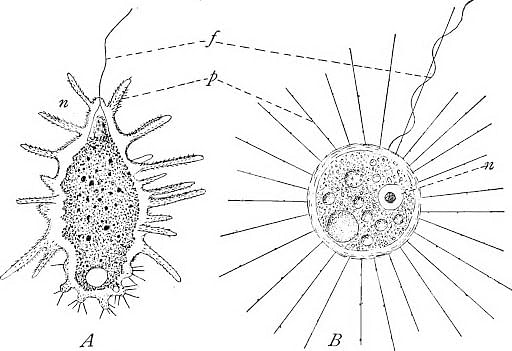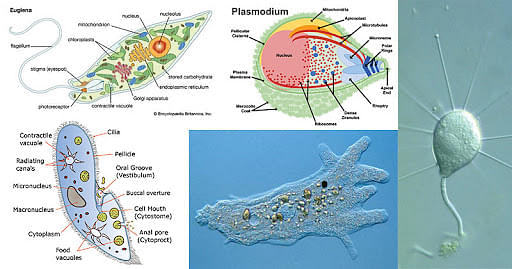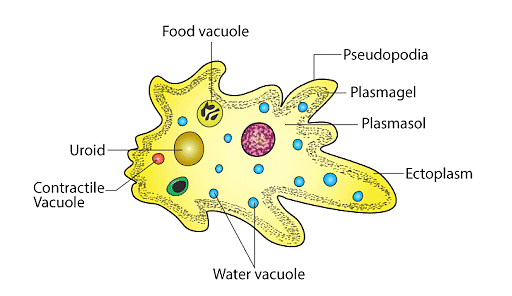Rhiti Mohanta Content Curator
Content Curator
Amoeboid protozoan resembles amoeba due to the presence of pseudopodia in it. Amoeboid is a type of unicellular microorganism that has the ability to change its shape by extending and retracting pseudopods. Amoeboids move and capture their prey by putting out pseudopodia which are also known to be their false feet as in Amoeba. Amoeboid protozoans lack periplast in their body so they are usually covered in calcareous shells and have temporary pseudopodia which help them in capturing the prey. Amoeboid protozoans cannot make their own food so are dependent on others for food.
| Table of Content |
Keyterms: Amoeba, Unicellular Microorganism, Protozoan, Holozoic nutrition, Entamoeba histolytica
Amoeboid Protozoan
[Click Here for Sample Questions]
Amoeboid protozoan likes to stay in aquatic or moist habitats. Amoeboid protozoans can be predators as well as parasitic. Amoeboid protozoan has holozoic nutrition. They are ubiquitous and are found everywhere.
- They are present in all aquatic or moist environments, and their cysts can be found in even the most inhospitable parts of the biosphere.
- There are many protozoa that cause various diseases in animals and humans such as malaria parasite, sleeping sickness, trichomoniasis, etc.
Example: Some of them such as Pelomyxa, Radiolarians, Heliozoans, and Foraminifera, and Entamoeba histolytica, Arcella, Difflugia, etc are some of the freshwater shell amoeboids. Marine form amoebas have silica shells on their surface.

Amoeboid Protozoan
Important Facts About Amoeboid Protozoan
[Click Here for Sample Questions]
The important facts about amoeboid protozoan are given below:
- Amoeboid protozoans are naked. They have no test oil shell.
- They can change their shape whenever they want.
- They use their pseudopodia to capture food.
- They are usually covered in calcareous shells.
- All the free-living amoebae are particle feeders.
- Sexual reproduction is not present in them.

Important Parts of Amoeboid protozoans
Also Read- Autotrophic Bacteria
Characteristics Of Amoeboid Protozoan
[Click Here for Sample Questions]
Some of the characteristics of amoeboid protozoan are:
- Amoeboid protozoans are mostly free-living, found in freshwater, seawater, and on damp soil. Only a few are parasitic.
- Their body is covered with plasma or a shell.
- Amoeboid protozoans are found in the aquatic environment. They live in freshwater or oceans.
- In Amoeboid Protozoan sexual reproduction occurs through syngamy.
- In Amoeboid Protozoan asexual reproduction takes place by binary fission, multiple fission, budding, and spores.
- Amoeboid Protozoans develop pseudopodia which are temporary protoplasmic outgrowths.
- Some amoeboid protozoans are free-living but some are parasitic and live attached to plants and animals.
- The life cycle of most of the amoeboid protozoan alternates between the dormant cyst stage and proliferating vegetative stage
- Sarcodines are generally uninucleate. Bi-nucleate (e.g., Arcella) and multinucleate (e.g., Pelomyxa) types also occur but the nuclei are monomorphic
- Nutrition is commonly holozoic.
- Pseudopodia in an amoeboid protozoan are used for locomotion and engulfing food articles.
Different Forms Of Pseudopodia In Amoeboid Protozoan
[Click Here for Sample Questions]
Amoeboid protozoan’s body lacks a Periplast. Therefore, they have temporary protoplasmic outgrowths called pseudopodia or a false foot which helps in movement and capturing prey. And some of the different forms of pseudopodia are:
- Lobopodia- Lobopodia which is also known as little foot is the broad cell process containing ectoplasm and endoplasm. Lobopodia are used for locomotion and engulfing their food.
- Filopodia- Filopodia which is also known to be thread contains only ectoplasm. Filopodia provide a constant two-way streaming movement that delivers food in a conveyor belt.
- Reticulopodia- Reticulopodia or which is also known to have a netlike structure is similar to filopodia but they are branched and rejoin to form a netlike series of cell extensions.
- Axpodia- Axpodia which is also called axle is a thin layer filamentous which are supported by a central axis of microtubules. The cytoplasms covering the central axis are adhesive and are movable.

Different Types of pseudopodia in Amoeboid Protozoan
Also Read- Creutzfeldt Jakob Disease
Diagram of Amoeboid Protozoan
[Click Here for Sample Questions]
Here is a diagram of amoeboid Protozoan-

Diagram Of Amoeboid Protozoan
Things to Remember
- Amoeboid protozoans can be described as a group of protozoans, which can be defined by their amoeboid movements.
- Their body lacks a Periplast.
- These kinds of protozoans are mostly free-living, found in freshwater, seawater, and on damp soil.
- Some of these protozoans are parasites.
- There are different types of Pseudopodia In Amoeboid Protozoan. For example- Lobopodia, Filopodia, Reticulopodia, axpodia.
SAMPLE QUESTIONS
Ques. What are the distinctive features of amoeboid protozoan? (2 Marks)
Ans- Amoeboid protozoan body lacks a Peri-plast. Therefore, they may be naked or covered by a calcareous shell. They usually lack flagella and have temporary protoplasmic outgrowths called pseudopodia for locomotion. These pseudopodia or false feet help in movement and capturing prey.
Ques. Is an amoeba a protozoan? (2 Marks)
Ans- Amoeba, also spelled ameba, plural amoebas or amoebae, any of the microscopic unicellular protozoans of the rhizopodan order Amoeboid. The well-known type Amoeba proteus is found on decaying bottom vegetation of freshwater streams and ponds. There are numerous parasitic amoebas.
Ques. When did protozoa first appear on earth? (1 Mark)
Ans- 1.5 billion years ago protozoa first appeared on earth.
Ques. Which of the following statements is wrong about the amoeboid protozoan? (1 Mark)
a) They live in freshwater, seawater, or moist soil
b) Amoeba has pseudopodia for locomotion and capturing prey
c) Entamoeba show holozoic nutrition
d) Marine forms are shelled with silica
Ans- d) Marine forms are shelled with silica
Ques. Where are amoeboid protozoans found in the body? (2 Marks)
Ans- Protozoa are ubiquitous and are found everywhere. They are present in all aquatic or moist environments, and their cysts can be found in even the most inhospitable parts of the biosphere. Most of the amoeboid protozoans are free-living and they feed on bacteria, algae, or other protozoa.
Ques. Which of the following is not a characteristic feature of protozoan? (1 Mark)
(a) Binary fission
(b) Contractile vacuole
(c) Cell membrane as an outer body covering
(d) Pseudopodia
Ans- c) Cell membrane as an outer body covering
Ques. What are the diseases caused by protozoa? (2 Marks)
Ans- Some of the diseases caused by protozoa are Malaria, Amoebiasis or Amoebic dysentery, African sleeping sickness or Trypanosomiasis, Trichomoniasis, Toxoplasmosis, Balantidiasis, Leishmaniasis or Kala-azar, and Giardiasis.
Ques. Which of the following protozoans causes African sleeping sickness? (1 Marks)
(a) Plasmodium vivax
(b) Entamoeba gingivalis
(c) Trypanosoma lewsii
(d) Trypanosoma gambiense
Ans- d) Trypanosoma gambiense
Ques. Unicellular eukaryotes are grouped in (1 Marks)
(a) Monera
(b) Protista
(c) Archaea
(d) Fungi
Ans- b) Protista
Ques. Is protozoan a bacteria? (2 Marks)
Ans- Protozoa (pro-toe-ZO-uh) are one-celled organisms, like bacteria. But they are bigger than bacteria and contain a nucleus and other cell structures, making them more similar to plant and animal cells.
Ques. Discuss how biological classification systems have undergone several changes over a period of time? (3 Marks)
Ans- With the passage of time, biological classification systems have undergone a number of alterations.
- Aristotle made the earliest attempt at classification. He divided plants into three categories: herbs, shrubs, and trees. Animals, on the other hand, were classed according to whether or not they had red blood cells.
- This classification system was unable to classify all known creatures.
- As a result, Linnaeus devised a two-kingdom classification system. It was divided into two kingdoms: Plantae and Animalia.
- This approach failed to distinguish between unicellular and multicellular creatures, as well as between eukaryotes and prokaryotes.
- As a result, a huge number of organisms could not be categorized into either of the two kingdoms.
- R.H Whittaker suggested a five-kingdom classification scheme in 1969 to address these issues. On the foundation of characteristics, such as cell structure, mode of nutrition, presence of cell wall, etc., five kingdoms, Monera, Protista, Fungi, Plantae, and Animalia were formed.
Also Read-
| Related Links | ||
|---|---|---|
| Two Kingdom Classification | Five Kingdom Classification | Heterotrophic Bacteria |
| Cyanobacteria | Lichens | Mycorrhiza |
| Prions | Kingdom Monera | where do microorganisms live |
Also Read:





Comments